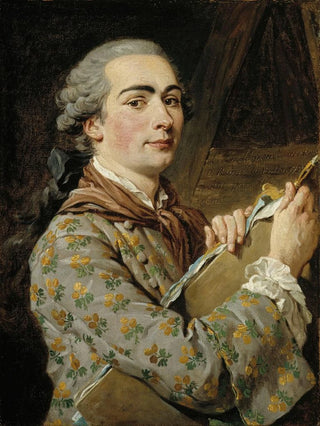Art print | Self-portrait - Louis-Jean-François Lagrenée


View from behind

Frame (optional)
Autoportrait Art print - Louis-Jean-François Lagrenée – Engaging Introduction
The Autoportrait by Louis-Jean-François Lagrenée is an iconic 18th-century work, a vibrant testament to the artistic soul of its time. In this canvas, the artist depicts himself with an intensity that transcends mere creation. The piece invites viewers to immerse themselves in a universe where light and shadow intertwine to reveal not only Lagrenée's face but also his spirit and aspirations. This portrait is more than just an image; it is an open window into the art world at the heart of the Enlightenment, where individuals began to claim their identity through art.
Style and uniqueness of the work
Lagrenée's style is distinguished by a remarkable mastery of painting techniques, blending elements of classicism while flirting with emerging romanticism. In this autoportrait, the delicate color palette and play of light create an almost theatrical atmosphere. The artist's penetrating gaze, captured with meticulous precision, seems to question the viewer, establishing a silent dialogue between the work and its observer. Every detail, from the drape of his clothing to the sparkle in his eyes, demonstrates a craftsmanship that combines academic rigor with personal sensitivity. This painting is not merely a reflection of the artist; it becomes a declaration of intent, a visual manifesto of his worldview.
The artist and his influence
Louis-Jean-François Lagrenée, born in 1739, is a key figure in 18th-century French art. Trained in the ateliers of the masters of his time, he established himself as a court painter and renowned portraitist. His work is marked by a constant pursuit of excellence and a desire to renew the aesthetic codes of his era. Lagrenée also played a pivotal role in transmitting neoclassical values, influencing many artists who followed him. His autoportrait, in particular, is not only a reflection of his talent but also an illustration of his commitment to art and culture. Through his creations, he managed to capture the essence of

Matte finish

View from behind

Frame (optional)
Autoportrait Art print - Louis-Jean-François Lagrenée – Engaging Introduction
The Autoportrait by Louis-Jean-François Lagrenée is an iconic 18th-century work, a vibrant testament to the artistic soul of its time. In this canvas, the artist depicts himself with an intensity that transcends mere creation. The piece invites viewers to immerse themselves in a universe where light and shadow intertwine to reveal not only Lagrenée's face but also his spirit and aspirations. This portrait is more than just an image; it is an open window into the art world at the heart of the Enlightenment, where individuals began to claim their identity through art.
Style and uniqueness of the work
Lagrenée's style is distinguished by a remarkable mastery of painting techniques, blending elements of classicism while flirting with emerging romanticism. In this autoportrait, the delicate color palette and play of light create an almost theatrical atmosphere. The artist's penetrating gaze, captured with meticulous precision, seems to question the viewer, establishing a silent dialogue between the work and its observer. Every detail, from the drape of his clothing to the sparkle in his eyes, demonstrates a craftsmanship that combines academic rigor with personal sensitivity. This painting is not merely a reflection of the artist; it becomes a declaration of intent, a visual manifesto of his worldview.
The artist and his influence
Louis-Jean-François Lagrenée, born in 1739, is a key figure in 18th-century French art. Trained in the ateliers of the masters of his time, he established himself as a court painter and renowned portraitist. His work is marked by a constant pursuit of excellence and a desire to renew the aesthetic codes of his era. Lagrenée also played a pivotal role in transmitting neoclassical values, influencing many artists who followed him. His autoportrait, in particular, is not only a reflection of his talent but also an illustration of his commitment to art and culture. Through his creations, he managed to capture the essence of






